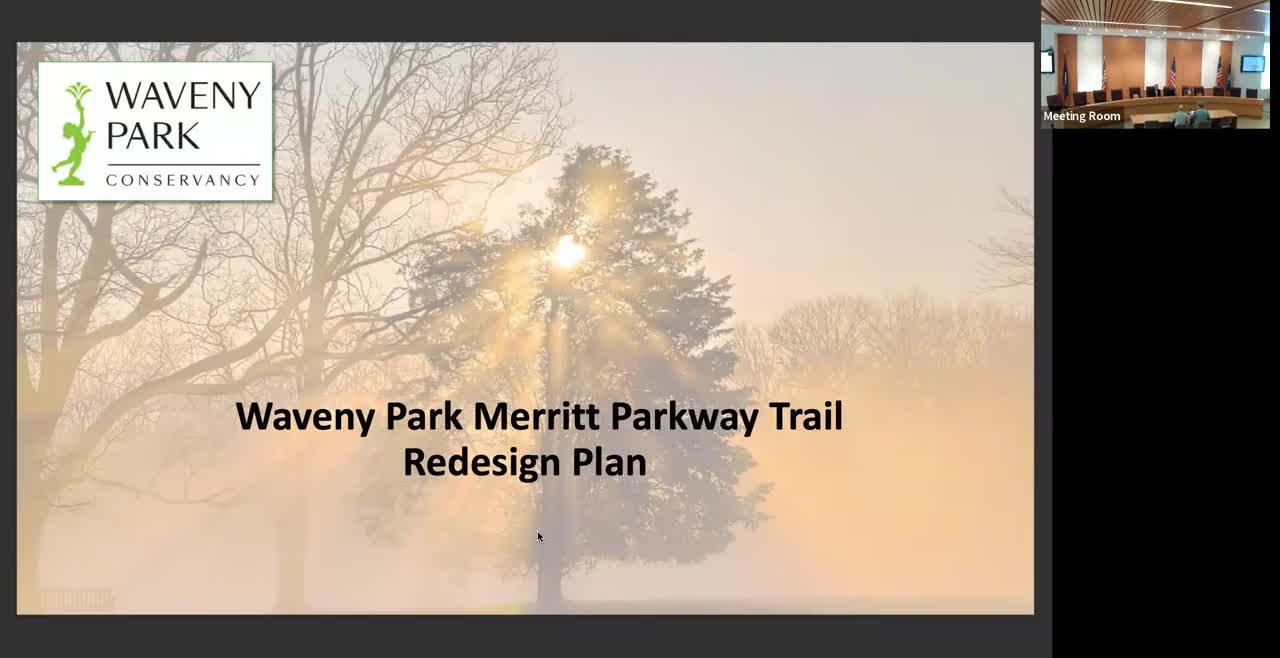Whitney/Waveny Conservancy outlines Merritt Trail redesign; estimates $2.5–3.5 million, seeks phased town support
October 21, 2025 | New Canaan, Fairfield, Connecticut
This article was created by AI summarizing key points discussed. AI makes mistakes, so for full details and context, please refer to the video of the full meeting. Please report any errors so we can fix them. Report an error »

Representatives of the Whitney/Waveny Park Conservancy presented a schematic plan on Oct. 21 to remediate sound and sight impacts from the Merritt Parkway along the Merritt Trail and to restore historic landscape character. The conservancy recommended a phased approach and introduced Heritage Landscapes as the project's landscape design partner.
What the plan would do: the design team recommended moving or re-routing parts of the trail away from the parkway where possible, expanding existing Olmsted-era berms, installing layback stone walls in exposed sections, and using selective fencing in constrained wetland areas. The proposal emphasizes native plantings, maintenance ease and restoring elements from the Olmsted toolkit that previously screened the park from the highway.
Cost and phasing: Heritage Landscapes prepared an order-of-magnitude estimate that placed the total project between $2.5 million and $3.5 million; the conservancy said phase 1—the section that pulls the trail away from the Merritt and adds berms and plantings—could cost roughly $1 million to $1.5 million. The conservancy indicated it holds town-designated reserves in the neighborhood of $682,000 (other figures on the record ranged up to about $780,000) and plans to run a capital campaign, pursue grants and seek town matching funds for future phases.
Schedule and constraints: the conservancy proposed further public outreach and detailed construction drawings in winter 2026, a capital campaign and grant work in 2026 and targeted construction beginning in summer 2027 if funding and approvals proceed. Presenters emphasized the project would be implemented in stages so much of the trail could remain open during construction.
Environmental and access notes: presenters said wetlands and right-of-way limits constrain routing in some sections and that an elevated, load-bearing trail to avoid wetlands would be cost prohibitive. They also cited Forest Service trail-accessibility guidance as part of the design criteria to improve grade and reduce maintenance in places.
The presentation was informational; no formal town funding or approvals were decided at the meeting.
What the plan would do: the design team recommended moving or re-routing parts of the trail away from the parkway where possible, expanding existing Olmsted-era berms, installing layback stone walls in exposed sections, and using selective fencing in constrained wetland areas. The proposal emphasizes native plantings, maintenance ease and restoring elements from the Olmsted toolkit that previously screened the park from the highway.
Cost and phasing: Heritage Landscapes prepared an order-of-magnitude estimate that placed the total project between $2.5 million and $3.5 million; the conservancy said phase 1—the section that pulls the trail away from the Merritt and adds berms and plantings—could cost roughly $1 million to $1.5 million. The conservancy indicated it holds town-designated reserves in the neighborhood of $682,000 (other figures on the record ranged up to about $780,000) and plans to run a capital campaign, pursue grants and seek town matching funds for future phases.
Schedule and constraints: the conservancy proposed further public outreach and detailed construction drawings in winter 2026, a capital campaign and grant work in 2026 and targeted construction beginning in summer 2027 if funding and approvals proceed. Presenters emphasized the project would be implemented in stages so much of the trail could remain open during construction.
Environmental and access notes: presenters said wetlands and right-of-way limits constrain routing in some sections and that an elevated, load-bearing trail to avoid wetlands would be cost prohibitive. They also cited Forest Service trail-accessibility guidance as part of the design criteria to improve grade and reduce maintenance in places.
The presentation was informational; no formal town funding or approvals were decided at the meeting.
View full meeting
This article is based on a recent meeting—watch the full video and explore the complete transcript for deeper insights into the discussion.
View full meeting
